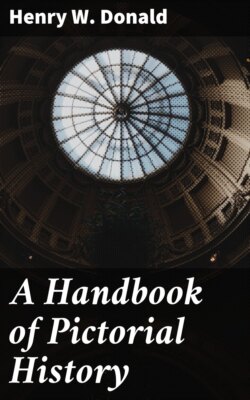Читать книгу A Handbook of Pictorial History - Henry W. Donald - Страница 12
На сайте Литреса книга снята с продажи.
ROMAN ARMS, Etc.
ОглавлениеTable of Contents
PLATE 8.
(Fig. 1): A Roman galley (from Pompeii). (Fig. 2): A Roman Eagle. This was mounted on a pole and carried before the Legion. The soldiers rallied round it and fought for its honour. It corresponded with the regimental flags of our time. (Fig. 3): A Roman sword. This was remarkable for the 25shortness of its blade. It was suspended from a shoulder belt passing over the left shoulder, so that the sword hung on the right side, a custom which was possible on account of the shortness of the blade. The length was about twenty-two inches. The blade was straight, of uniform width, double-edged, and cut at the end in an obtuse angle to form the point. (Fig. 4): A short sword or sword dagger. (Fig. 5): Scabbard of the same. (Fig. 6): A Roman Centurion, with an oval shield, such as was generally carried by horse soldiers. The body was protected by a metal cuirass formed of back and breast plates, strapped together at the sides, and fastened by broad belts passing over the shoulders. At the lower part of the cuirass were two bands of leather, one showing underneath the other, the edges of both being tagged or scalloped. Below this double border there was a kind of leather skirt, reaching nearly to the knee. A military cloak or mantle was picturesquely draped over the shoulder. Metal greaves covered the shins, and sandals, which were often highly ornamented, covered the feet. (Fig. 7): A Roman laminated cuirass worn by the heavily armed troops. It consisted of lames or plates of steel encircling the body, with curved lames passing over the shoulders, and several lames hanging vertically over the lower part of the trunk. They were sewn or rivetted to a tightly-fitting leather garment. (Figs. 8, 9 and 10): Roman helmets, all fitted with neck pieces to guard the neck—Figs. 8 and 9 with cheek pieces, hinged and fastening beneath the chin. (Fig. 11): Another form of shield, differing entirely from that in Fig. 6. “It is elongated and convex oblong, somewhat resembling a hollow watercourse tile.” It was carried by the legionaries, and was about 2 ft. 6 in. long. It was strengthened, at the top and bottom only, or all round, with additional bands of metal. With this form of shield, the well-known testudo or tortoise formation was made. (Fig. 12): A Roman sandal of leather.
